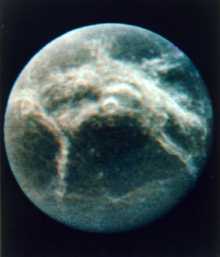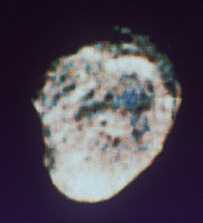This is an image of Helene.
NASA
Helene
Helene was discovered by
the French astronomers Pierre Laques, Raymond Despiau and J. Lecacheux on
February 29, 1980.
Even though Helene is so far away, they were able to make their discovery
at an observatory in France using a telescope and electronographic
camera. A few months later, P. Laques and J.
Lecacheux, along with the other members of the Voyager team, confirmed
the discovery of Helene with pictures taken from space.
Helene is the 6th
farthest moon from Saturn, with a standoff distance of 377,400 km. Helene is one of the small moons, and is just 18 x 15 km (12 x 10 miles) in size. Its dimensions make Helene about the size of a medium city.
The surface features can just barely be distinguished in this image. Nevertheless, as a small moon, details about the composition and
structure of the moon are unknown.
You might also be interested in:

The gas giant planet Saturn has a large group of // Call the moon count function defined in the document head print_moon_count('saturn'); moons. It also has the largest, most complex, and best-known ring
...more
This is an image of the Earth's moon, shown in the lower left, with the much smaller icy moons of Saturn. The moons in order, starting from the top left are: Mimas, Enceladus, Tethys, Dione, Rhea, and
...more
Dione was discovered by G. Cassini in 1684. Dione is the 7th farthest moon from Saturn, with a standoff distance of 377,400 km. It is a small icy moon, lightly cratered, with wispy white streaks across
...more
The surface of Dione does not have many craters. Instead it has wispy white streaks similar to those found on Rhea extending for many kilometers over the entire surface. These two things indicate that
...more
The surface of Enceladus does not have many craters. Instead it has grooves similar to those found on Ganymede. These grooves extend for many kilometers over the surface. The presence of grooves indicates
...more
Helene was discovered by the French astronomers Pierre Laques, Raymond Despiau and J. Lecacheux on February 29, 1980. Even though Helene is so far away, they were able to make their discovery at an observatory
...more
Hyperion was discovered by W. Bond in 1848. Hyperion is the 3rd farthest moon from Saturn, with a standoff distance of 1,481,000 km. Hyperion is 175 x 100 km (117 x 67 miles) in size. Its dimensions make
...more
Rhea was discovered by G. Cassini in 1672. Rhea is the 5th farthest moon from Saturn. It is one of the icy moons, similar to the Galilean satellites. Rhea is about as wide as the state of California is
...more












